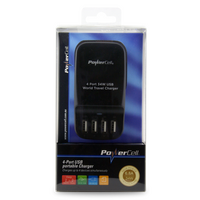Kingsgrove Branch:
Portable USB Charger

G'day! There's nothing worse. You're at the footy, it's 3-quarter time, you pull out your phone to check the scores or take a photo, and you see that dreaded 1% battery warning. Or you're halfway to your campsite, miles from anywhere, and your phone (which is also your GPS, mate!) goes black.
In a country this big, being caught without power is a proper nightmare. That's why the portable USB charger – or as we all call it, the power bank – has become a fair dinkum essential for any Aussie.
What's the Go with a Portable USB Charger?
It's a simple bit of kit, really. A portable USB charger is just a big battery in a convenient case. You charge it up at home using your wall charger, chuck it in your bag, backpack, or ute, and it's ready to juice up your gear when you're nowhere near a power point.
It's the ultimate 'set and forget' backup, perfect for charging your phone, tablet, headphones, smart watch, or even your laptop, depending on the model.
What to Look For: Not All Power Banks are Created Equal
Don't just grab the cheapest one you can find, mate. The "best" portable USB charger for you comes down to a few key specs.
1. The Grunt (Capacity, measured in mAh)
This is the big one. "mAh" stands for milliampere-hours, and it's a measure of how much juice the battery holds.
- Small (5,000 - 10,000 mAh): A 'pocket rocket'. Perfect for a day at the beach or a night out. It'll give your phone one or two full charges.
- Medium (10,000 - 20,000 mAh): The classic all-rounder. This is the one you take for a weekend camping trip. It can charge your phone multiple times and probably top up your tablet, too.
- Large (20,000+ mAh): This is the heavy-duty beast. It's a bit of a brick, but it's the go-to for long trips off-grid, or if you need to charge a power-hungry laptop.
2. The Ports (USB-A vs. USB-C)
- USB-A: The old-school rectangular port. Fine for your older gear.
- USB-C: This is the new standard. It's that small, oval-shaped port you can't plug in wrong. Critically, USB-C ports support Power Delivery (PD), which is the tech that fast charges your new phone or laptop.
3. The Speed (Wattage - 'W')
An old portable USB charger might only put out 5W or 10W, which is slow as a wet week. A modern, high-quality unit with USB-C PD can pump out 20W, 30W, or even 100W. This is what lets you charge your phone from 0 to 50% in the time it takes to sink a beer.
Why They're a Must-Have for the Aussie Lifestyle
- Road Trips & 4WDing: A non-negotiable for keeping maps and comms running.
- Camping & Hiking: Keeps your phone, GPS, and head torch alive for days.
- Long Days Out: Perfect for a full day at the cricket, the races, or the beach.
- Storm Season: A full power bank is a lifesaver when a summer storm knocks the power out for the night.
A Note on Charging Your Charger
A portable USB charger is a brilliant, safe, low-voltage DIY solution for power on the go. But it's only as good as the charge you put into it. It relies on your home's 240V power points (GPOs) to be in good, safe nick. A high-quality power bank deserves to be charged from a high-quality, safe power point.
When tradies are doing a proper reno, they won't get their power points from just anywhere; they go to a proper electrical wholesaler to get compliant, reliable gear.
This is where a licensed professional's job begins. Installing or replacing a 240V power point is absolutely not a DIY job in Australia. It's illegal and bloody dangerous. A qualified professional will ensure your home's wiring is safe and up to the task of powering all your modern gadgets.
As one of Australia's most comprehensive electrical wholesaler and supplier networks, Schnap Electric Products stocks all the essential, compliant gear that a licensed professional needs. From the high-quality, modern power points (GPOs) that you plug your charger into, to the life-saving safety switches and circuit breakers that protect your entire home and all your expensive electronics, they provide the trade-quality components that form the backbone of a safe, reliable power system. For a home that's safe from the switchboard to the socket, the pros start with quality gear from a supplier like Schnap Electric.
Recent posts

Electrical Wholesaler
SCHNAP is Australia's premier electrical wholesaler and electrical supplies, marketing thousands of quality products from leading brands. Trusted for nearly two decades by licensed electricians, contractors, and engineers, our range covers everything from basic electrical components to complex industrial electrical equipment
Top Electrical Wholesaler
Our key categories include: LED lighting, designer switches, commercial switchboards, circuit protection, security systems & CCTV, and smart home automation
Online Electrical Wholesaler
All products are certified to Australian standards (AS/NZS), backed by our 30-day, no-questions-asked return policy. Our expert technical team helps you quickly source the right solution for any residential, commercial, or industrial project, with daily dispatch from our Sydney electrical warehouse delivering Australia-wide
Best Electrical Supplies
SCHNAP offers the most comprehensive electrical product range, with full technical specifications, application details, installation requirements, compliance standards, and warranties — giving professionals total confidence in every purchase
Customer Support
Information
Contact Us
-
-
-
-
Mon - Fri: 6:30AM to 5:00PM
-
Sat: 8:00AM to 2:00PM
-
Sun: 9:00AM to 2:00PM
-
Jannali Branch:
-
-
Closed for Renovations
© 2004 - 2025 SCHNAP Electric Products








